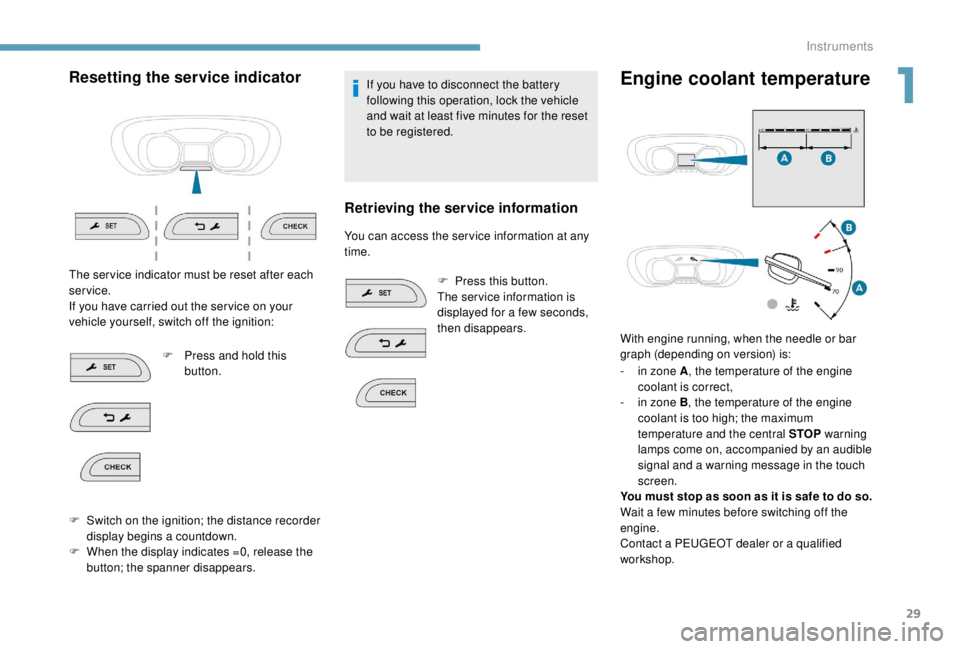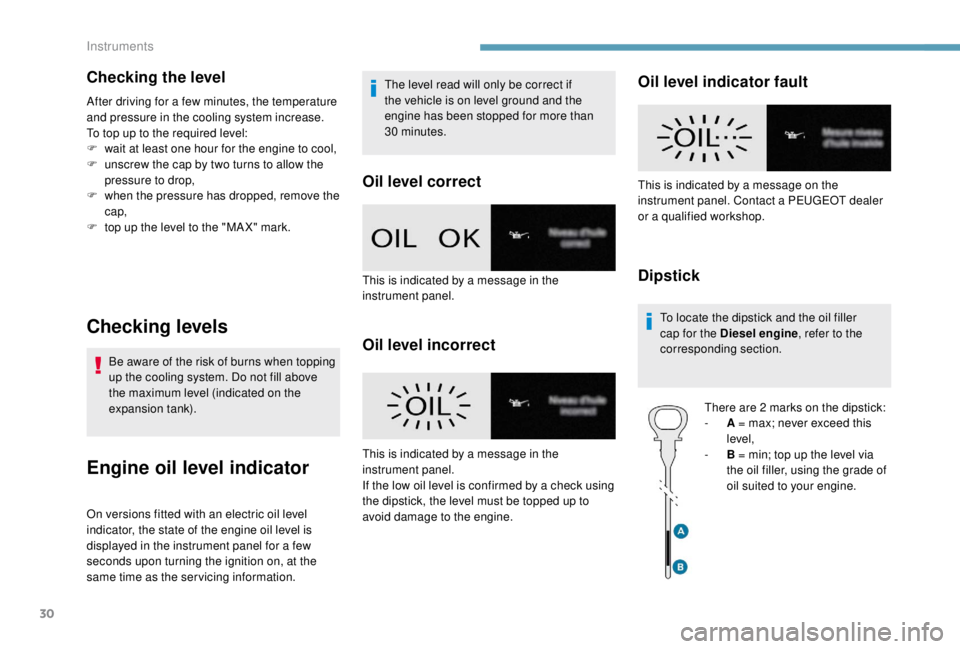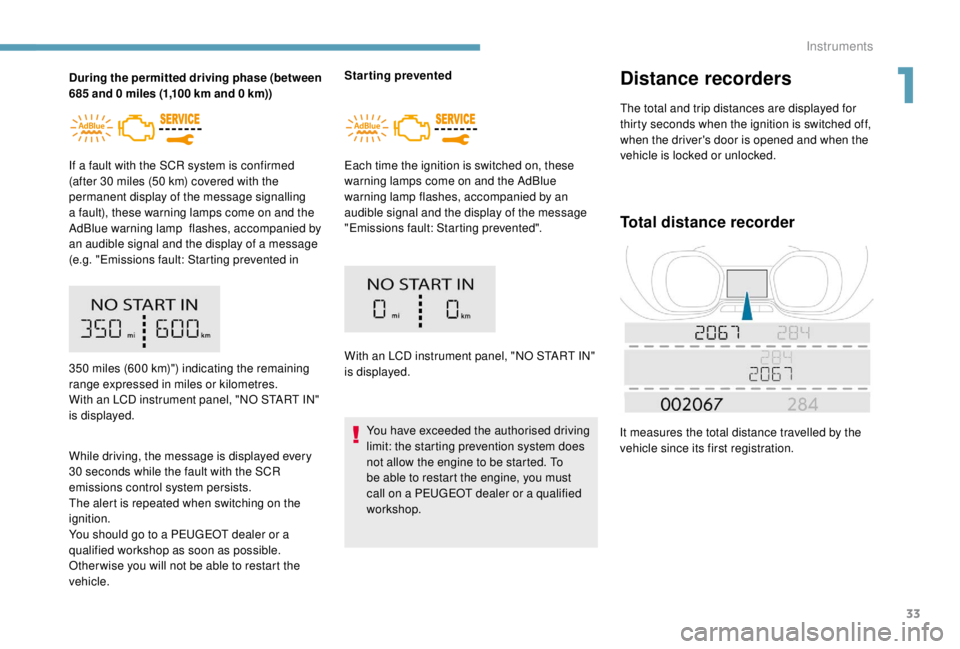2018 PEUGEOT EXPERT engine
[x] Cancel search: enginePage 31 of 416

29
Resetting the service indicator
The ser vice indicator must be reset after each
service.
If you have carried out the ser vice on your
vehicle yourself, switch off the ignition:F
P
ress and hold this
button.
F
S
witch on the ignition; the distance recorder
display begins a countdown.
F
W
hen the display indicates =0, release the
button; the spanner disappears. If you have to disconnect the battery
following this operation, lock the vehicle
and wait at least five minutes for the reset
to be registered.
Retrieving the service information
You can access the ser vice information at any
time.
F
P
ress this button.
The ser vice information is
displayed for a few seconds,
then disappears.
Engine coolant temperature
With engine running, when the needle or bar
graph (depending on version) is:
-
i
n zone A , the temperature of the engine
coolant is correct,
-
i
n zone B , the temperature of the engine
coolant is too high; the maximum
temperature and the central STOP warning
lamps come on, accompanied by an audible
signal and a warning message in the touch
screen.
You must stop as soon as it is safe to do so.
Wait a few minutes before switching off the
engine.
Contact a PEUGEOT dealer or a qualified
workshop.
1
Instruments
Page 32 of 416

30
Checking the level
After driving for a few minutes, the temperature
and pressure in the cooling system increase.
To top up to the required level:
F
w
ait at least one hour for the engine to cool,
F
u
nscrew the cap by two turns to allow the
pressure to drop,
F
w
hen the pressure has dropped, remove the
cap,
F
t
op up the level to the "MA X" mark.
Checking levels
Be aware of the risk of burns when topping
up the cooling system. Do not fill above
the maximum level (indicated on the
expansion tank).
Engine oil level indicator
On versions fitted with an electric oil level
indicator, the state of the engine oil level is
displayed in the instrument panel for a few
seconds upon turning the ignition on, at the
same time as the ser vicing information. The level read will only be correct if
the vehicle is on level ground and the
engine has been stopped for more than
30
minutes.
Oil level correct
Oil level incorrect
Oil level indicator fault
Dipstick
To locate the dipstick and the oil filler
cap for the Diesel engine
, refer to the
corresponding section.
There are 2
marks on the dipstick:
-
A
= max; never exceed this
level,
-
B
= min; top up the level via
the oil filler, using the grade of
oil suited to your engine.
This is indicated by a message in the
instrument panel.
This is indicated by a message in the
instrument panel.
If the low oil level is confirmed by a check using
the dipstick, the level must be topped up to
avoid damage to the engine. This is indicated by a message on the
instrument panel. Contact a PEUGEOT dealer
or a qualified workshop.
Instruments
Page 33 of 416

31
AdBlue® fluid range
indicators
Once the AdBlue® tank is on reser ve or after
detection of a fault with the SCR emissions
control system, when the ignition is switched
on, an indicator displays an estimate of the
distance that can be covered, the range, before
engine starting is prevented.
If a system fault and low AdBlue
® level occur
at the same time, the lowest range is the one
displayed.
In the event of the risk of non-
starting related to a lack of
AdBlue
®
The engine start prevention system
required by regulations is activated
automatically once the AdBlue
® tank is
e m pt y.
Range greater than 1,500
miles (2,400 km)
When switching on the ignition, there is no
automatic display of range in the instrument
panel. Pressing this button will temporarily display the
remaining range.
Remaining range between 1,500
and
375 miles (2,400 and 600 km)
When switching on the ignition, this warning
lamp comes on, accompanied by an audible
signal and the display of a message (e.g. "Top
up emissions additive: Starting prevented in
900 miles (1,500 km)") indicating the remaining
range expressed in miles or kilometres. With an LCD instrument panel, "NO START IN"
is displayed.
When driving, the message comes up
approximately every 200
miles (300 km) until
the tank is topped up.
The reser ve level has been reached; it is
recommended that you top up as soon as
possible.
Range less than 375 miles (600 km)
When switching on the ignition, this warning
lamp flashes, accompanied by an audible
signal and the display of a message (e.g. "Top
up emissions additive: Starting prevented in
200 miles (300 km)") indicating the remaining
range in miles or kilometres.
With touch screen
You can access the information via
the Driving/Vehicle menu.
1
Instruments
Page 34 of 416

32
With an LCD instrument panel, "NO START IN"
is displayed.
When driving, this message is displayed every
30 seconds until the AdBlue level has been
topped up.
It is essential to top up as soon as possible and
before the tank is completely empty; other wise
it will not be possible to restart the engine after
the next stop.
For more information on the AdBlue
®
(BlueHDi engines) , and in particular on
topping up, refer to the corresponding
section.
Breakdown related to a lack of AdBlue
®
When switching on the ignition, this
warning lamp flashes, associated
with an audible signal and the
display of the message "Top
up emissions additive: Starting
prevented". With an LCD instrument panel, "NO START IN"
is displayed.
The AdBlue
® tank is empty: the starting
inhibition system required by legislation
prevents starting of the engine.
To be able to restart the engine, it is
essential to add at least 4
litres of AdBlue
®
to its tank.
In the event of a fault with the
SCR emissions control system
An engine immobiliser is activated
automatically after you have driven a
further 685
miles (1,100 km) following
confirmation of a fault with the SCR
emissions control system. Have the
system checked by a PEUGEOT dealer or
a qualified workshop as soon as possible. In the event of the detection of a fault
These warning lamps come on, accompanied
by an audible signal and the display of the
message "Emissions fault".
The alert is triggered while driving as soon
as the fault is detected for the first time, then
when switching on the ignition for subsequent
journeys, while the fault persists.
If it is a temporary fault, the alert
disappears during the next journey,
after self-diagnostic checks of the SCR
emissions control system.
Instruments
Page 35 of 416

33
During the permitted driving phase (between
685 and 0 miles (1,100 km and 0 km))
If a fault with the SCR system is confirmed
(after 30
miles (50 km) covered with the
permanent display of the message signalling
a fault), these warning lamps come on and the
AdBlue warning lamp flashes, accompanied by
an audible signal and the display of a message
(e.g. "Emissions fault: Starting prevented in
While driving, the message is displayed every
30
seconds while the fault with the SCR
emissions control system persists.
The alert is repeated when switching on the
ignition.
You should go to a PEUGEOT dealer or a
qualified workshop as soon as possible.
Other wise you will not be able to restart the
vehicle. Starting prevented
Each time the ignition is switched on, these
warning lamps come on and the AdBlue
warning lamp flashes, accompanied by an
audible signal and the display of the message
"Emissions fault: Starting prevented".
With an LCD instrument panel, "NO START IN"
is displayed.
You have exceeded the authorised driving
limit: the starting prevention system does
not allow the engine to be started. To
be able to restart the engine, you must
call on a PEUGEOT dealer or a qualified
workshop.Distance recorders
The total and trip distances are displayed for
thirty seconds when the ignition is switched off,
when the driver's door is opened and when the
vehicle is locked or unlocked.
Total distance recorder
It measures the total distance travelled by the
vehicle since its first registration.
350
miles (600 km)") indicating the remaining
range expressed in miles or kilometres.
With an LCD instrument panel, "NO START IN"
is displayed.
1
Instruments
Page 41 of 416

39
Key
The key allows the central locking or unlocking
of the vehicle using the door lock.
It also allows the fuel filler cap to be removed
and refitted and the engine started or switched
of f.
Key, remote control
The remote control buttons are not active
when the ignition is switched on.
Unfolding/Folding the key
If you do not press the button, you risk
damaging the remote control.
What is the purpose of total
or selective unlocking?
F Press this button to unfold or fold the key.Selective unlocking unlocks either the cab
doors, or the doors of the loading area (side
and rear). Total unlocking unlocks all
the vehicle’s doors
(front, side and rear).
The separated unlocking system between
cab and loading area is a security
measure.
It is used to close access to the part of the
vehicle in which you are not.
It allows the central locking or unlocking of the
vehicle using the door lock or from a distance. It also allows the vehicle to be located, the fuel
filler cap to be removed and refitted and the
engine to be started or switched off, as well as
providing protection against theft.
2
Access
Page 44 of 416

42
Locking
Using the key
F To lock the vehicle totally, turn the key to
the rear of the vehicle.
If your vehicle has an alarm, this will not be
activated.
Using the remote control
F To lock the vehicle totally , press
this button.
Ensure that no person or object could
prevent the correct closing of the windows.
Be particularly aware of children when
operating the windows.
If a door is not properly closed
(except the right-hand door with side-
hinged rear doors):
-
w
ith the vehicle stationary and
the engine running, this warning
lamp comes on, accompanied
by an alert message for a few
seconds,
-
w
ith the vehicle moving (speed
above 6
mph (10 km/h)), this
warning lamp comes on,
accompanied by an audible
signal and an alert message for a
few seconds. Driving with the doors locked could make
it difficult for the emergency ser vices to
enter the vehicle in an emergency.
As a safety measure (children on board),
never leave the vehicle without your
remote control with you, even for a short
period.
Using the remote control with
electric sliding side door(s)
F To unlock the vehicle
and open the side door,
press and hold this
button until the door has
opened.
Unlocking is confirmed by rapid flashing
of the direction indicators for around two
seconds.
At the same time, depending on your
version, the door mirrors unfold. If your vehicle is not fitted with an
alarm, locking is signalled by the fixed
illumination of the direction indicators for
about two seconds.
At the same time, depending on your
version, the door mirrors fold.
If one of the opening elements (doors or
tailgate) is still open, the central locking
does not take place.
When the vehicle is locked, if it is
unlocked inadvertently, it will lock itself
again automatically after about thirty
seconds unless a door is opened.
And if your vehicle has an alarm, this will
be reactivated (with volumetric monitoring,
even if this had been deactivated).
The automatic folding and unfolding of the
electric door mirrors can be deactivated
by a PEUGEOT dealer or a qualified
workshop.
Access
Page 46 of 416

44
Anti-theft protection
Electronic engine immobiliser
The remote control contains an electronic chip
which has a secret code. When the ignition is
switched on, this code must be recognised in
order for starting to be possible.
A few seconds after switching off the ignition,
this system locks the engine control system,
therefore preventing the engine from being
started in the event of a break-in.In the event of a fault, you are
informed by illumination of this
warning lamp, an audible signal and
a message in the screen.
The vehicle will not start; contact a PEUGEOT
dealer as soon as possible.
B a c k- u p c o nt r o l (s)
Locking the driver's door
F Insert the key in the door lock, then turn it to the rear.
Unlocking
F Insert the key in the door lock, then turn it to the front. If your vehicle has an alarm, it will not be
deactivated/activated on unlocking/locking
the vehicle.
Opening a door will trigger the alarm,
which can be stopped by switching the
ignition on.
Locking the front
passenger door
F Open the door.
F
R
emove the cap on the edge of the door.
F
I
nsert the key into the latch aperture
(without forcing) and turn the assembly.
F
R
emove the key and refit the cap.
F
C
lose the door and check from the outside
that it has locked correctly.
For mechanically locking and unlocking the
doors in the event of a fault with the central
locking system or a battery failure.
Access